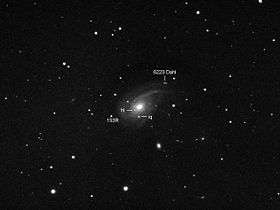6223 Dahl
| Discovery [1] | |
|---|---|
| Discovered by | A. Mrkos |
| Discovery site | Kleť Obs. |
| Discovery date | 3 September 1980 |
| Designations | |
| MPC designation | 6223 Dahl |
Named after | Roald Dahl (author)[2] |
|
1980 RD1 · 1949 XC 1972 YS · 1976 UV3 1982 BH9 · 1991 AK3 | |
| main-belt · (outer) [3] | |
| Orbital characteristics [1] | |
| Epoch 31 July 2016 (JD 2457600.5) | |
| Uncertainty parameter 0 | |
| Observation arc | 66.51 yr (24,291 days) |
| Aphelion | 3.0669 AU |
| Perihelion | 2.4038 AU |
| 2.7354 AU | |
| Eccentricity | 0.1212 |
| 4.52 yr (1,652 days) | |
| 311.49° | |
| 0° 13m 4.44s / day | |
| Inclination | 3.8567° |
| 294.33° | |
| 76.414° | |
| Physical characteristics | |
| Dimensions |
16.81 km (calculated)[3] 19.634±0.326 km[4] |
| 3.33±0.01 h[5] | |
|
0.0335±0.0040[4] 0.057 (assumed)[3] | |
| C [3] | |
| 12.6[1][3][4] | |
|
| |
6223 Dahl, provisional designation 1980 RD1, is a carbonaceous asteroid from the outer region of the asteroid belt, approximately 18 kilometers in diameter. It was discovered on 3 September 1980, by Czech astronomer Antonín Mrkos at Kleť Observatory near České Budějovice in the Czech Republic.[6]
The dark C-type asteroid orbits the Sun at a distance of 2.4–3.1 AU once every 4 years and 6 months (1,652 days). Its orbit has an eccentricity of 0.12 and an inclination of 4° with respect to the ecliptic.[1] The first precovery was taken at the U.S. Goethe Link Observatory in 1949, extending the asteroid's observation arc by 31 years prior to its discovery.[6]

In November 2011, a rotational light-curve for this asteroid was obtained by Brett Waller at the U.S. Cedar Green Observatory in Virginia. It gave a rotation period of 3.33±0.01 hours with a brightness variation of 0.43 in magnitude (U=2).[5]
According to the survey carried out by the NEOWISE mission of NASA's Wide-field Infrared Survey Explorer, the asteroid measures 19.6 kilometers in diameter and its surface has an low albedo of 0.034,[4] while the Collaborative Asteroid Lightcurve Link assumes a standard albedo for carbonaceous asteroids of 0.057 and calculates a diameter of 16.8 kilometers, as the higher the albedo (reflectivity), the lower the body's diameter at a constant absolute magnitude.[3]
The minor planet was named in memory of the Welsh author Roald Dahl (1916–1990), known for his classic children's books Willy Wonka and the Chocolate Factory and James and the Giant Peach.[2] Naming citation was published on 28 August 1996 (M.P.C. 27735).[7]
References
- 1 2 3 4 "JPL Small-Body Database Browser: 6223 Dahl (1980 RD1)" (2016-06-16 last obs.). Jet Propulsion Laboratory. Retrieved 10 July 2016.
- 1 2 Schmadel, Lutz D. (2007). Dictionary of Minor Planet Names – (6223) Dahl. Springer Berlin Heidelberg. p. 519. ISBN 978-3-540-00238-3. Retrieved 10 July 2016.
- 1 2 3 4 5 6 "LCDB Data for (6223) Dahl". Asteroid Lightcurve Database (LCDB). Retrieved 10 July 2016.
- 1 2 3 4 Mainzer, A.; Grav, T.; Masiero, J.; Hand, E.; Bauer, J.; Tholen, D.; et al. (November 2011). "NEOWISE Studies of Spectrophotometrically Classified Asteroids: Preliminary Results". The Astrophysical Journal. 741 (2): 25. arXiv:1109.6407
 . Bibcode:2011ApJ...741...90M. doi:10.1088/0004-637X/741/2/90. Retrieved 10 July 2016.
. Bibcode:2011ApJ...741...90M. doi:10.1088/0004-637X/741/2/90. Retrieved 10 July 2016. - 1 2 Waller, E. Brett (April 2013). "Lightcurve Photometry and Rotational Periods of 2890 Vilyujsk and 6223 Dahl". The Minor Planet Bulletin. 40 (2): 109–110. Bibcode:2013MPBu...40..109W. Retrieved 10 July 2016.
- 1 2 "6223 Dahl (1980 RD1)". Minor Planet Center. Retrieved 10 July 2016.
- ↑ "MPC/MPO/MPS Archive". Minor Planet Center. Retrieved 10 July 2016.
External links
- Asteroid Lightcurve Database (LCDB), query form (info)
- Dictionary of Minor Planet Names, Google books
- Asteroids and comets rotation curves, CdR – Observatoire de Genève, Raoul Behrend
- Discovery Circumstances: Numbered Minor Planets (5001)-(10000) – Minor Planet Center
- 6223 Dahl at the JPL Small-Body Database
